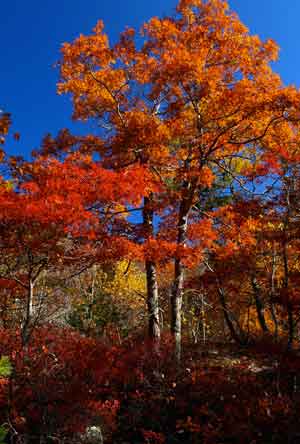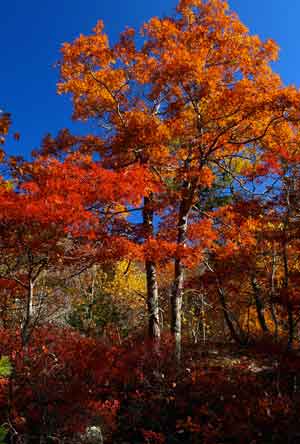 It has already begun working its way south, and it should be arriving in Rhode Island in another week or two. For many in New England, it’s the reason they love the autumn season the most.
It has already begun working its way south, and it should be arriving in Rhode Island in another week or two. For many in New England, it’s the reason they love the autumn season the most.
Local trees are beginning to show hints of the blazing reds and oranges and yellows of their stunning fall foliage, yet many local leaf peepers still don’t know why the leaves change color.
Keith Killingbeck does. A botany professor in the Department of Biological Sciences and associate dean of the Graduate School, he studies the ecology and physiology of plant nutrient dynamics, which gives him the perfect perspective for explaining the phenomenon.
“When plants can no longer photosynthesize efficiently — due to cold temperatures and their inability to take up water any more — they jettison their leaves,” Killingbeck said. “But before they do, they break down the photosynthetic compounds in the leaves and extract some of the nutrients from them that they have a hard time getting anywhere else.”
Nitrogen and phosphorus are the compounds in greatest demand in the ecosystem. Rather than seek to get all of the compounds they need from the soil, they break down the molecules they had previously utilized in their leaves and store them in their bark or roots to use to make leaves the following year. It’s a process called resorption.
“Leaves are green because of chlorophyll,” Killingbeck explained. “When the chlorophyll molecules are broken down and disappear, it unmasks other colors. Sugar maples turn peachy, maples turn red and yellow, beech and aspen turn yellow, and sumacs turn red.”
Some of this color comes from the tree’s production of new biochemicals to protect various plant functions from high amounts of light, he added.
New England trees have the reputation for producing some of the most beautiful fall colors of anywhere in North America, and that is largely because of the mix of tree species, including evergreens, in the region’s landscape.
“It’s that mix of colors that makes New England so spectacular in the fall,” Killingbeck said. “And our hilly topography often makes it possible for us to look down on the tree canopy like looking at a carpet of intermingled colors. That’s really special.”
In New England, the foliage is at its peak color in mid-October, but it varies by species. Red maples are at their brightest in early October, while most oaks don’t turn until late October. The timing of the change is driven largely by photoperiod – the shortening period of daylight as the fall progresses.
“It’s also related to the temperature,” said Killingbeck. “If we get lots of cold days in a row, that can speed up the process, to some extent. And drought can, too.”
So climb on your bike, take a hike, or enjoy a drive through the country. Just don’t miss New England’s fall spectacle of color.
Photograph above by Professor Killingbeck.

